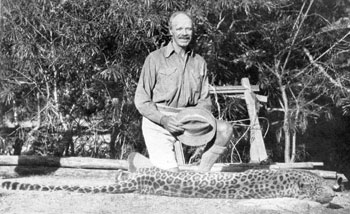History’s most prolific man-eaters stalked Northern India during the early 20th century. One man, big-game hunter and author Jim Corbett, hunted down 33 man-eaters responsible for well over 1,000 deaths. The following are his most well known.
Leopard of Rudraprayag

Jim Corbett with the Leopard of Rudraprayag, which killed 250 people and measured 7’10”.
It’s believed the Leopard of Rudraprayag turned to man-eating after the 1918 flu pandemic that caused millions of deaths in India. So many died that the normal rites of cremation weren’t performed and the plague’s victims were left in shallow, mass graves or even unburied. Scavenging from the corpses, the leopard learned man was an easy meal.
Roaming the Uttarkhan area of Northern India for 8 years, the leopard terrified villages. In the middle of the night, his victims would wake to find the cat clawing through their thatched mud walls to drag them from their beds, according to factoflife
Panar LeopardWhile not as famous as the Leopard of Rudraprayag because it hunted a more secluded area of India and didn’t catch the attention of journalists, the Panar Leopard was still feared and hated in the Northern part of India’s Kumaon District.
After a poacher shot him, the Panar Leopard turned to man-eating and killed over 400 people before Jim Corbett killed it in 1910.
Champawat Tiger - tiger facts
This female Bengal tiger known as the Champawat Tiger began her man-eating in Nepal. There, she killed an estimated 200 people before the Nepalese army was called in to hunt her down. Though the army failed to kill the man-eater, they did succeed in scaring her across the River Serda and into India.
Once in India, the tigers continued her man-eating ways and claimed a further 236 victims. Her final victim, a 16-year-old girl, was killed just hours before Jim Corbett hunted her down in 1907.
Once in India, the tigers continued her man-eating ways and claimed a further 236 victims. Her final victim, a 16-year-old girl, was killed just hours before Jim Corbett hunted her down in 1907.
For more: animal facts
0 comments:
Post a Comment